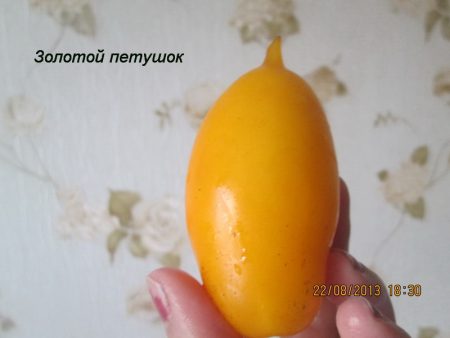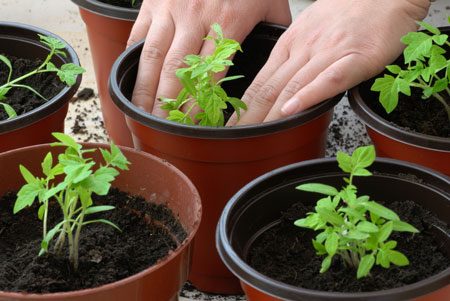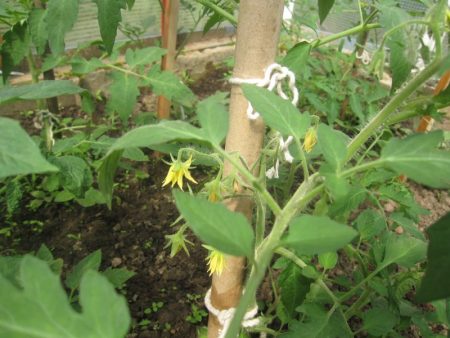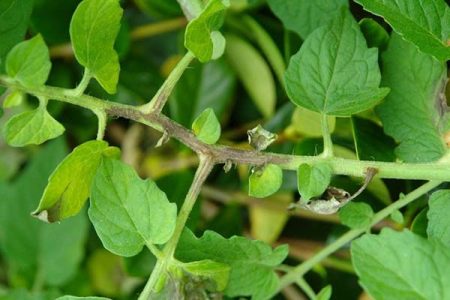 Many gardening enthusiasts grow the same tomato varieties from year to year, arguing that proven options will never fail. But domestic selection does not stand still and regularly offers new, more high-yielding and resistant to diseases, as well as varieties universal in designation.
Many gardening enthusiasts grow the same tomato varieties from year to year, arguing that proven options will never fail. But domestic selection does not stand still and regularly offers new, more high-yielding and resistant to diseases, as well as varieties universal in designation.
One of them is the Golden Cockerel tomato, which can be grown everywhere, both in greenhouse conditions and in open soil.
Content
Grade characteristics
“Golden Cockerel” is a medium-late variety with a long fruiting period, recognized as one of the most delicious yellow-fruited tomatoes. Versatile in purpose, it is long and well stored, suitable for long-term transportation due to the meatiness and elasticity of the fruit.
Plant features
The bush of indeterminate (tall) type, its height reaches 2 m, most often is 1.6-1.8 m. The stems are powerful, the leaves have the usual shape and size, the plant needs a garter and pinching, which should be carried out throughout the growing season period. It develops faster in warm climates or in greenhouse conditions. It can be grown in one stalk, but the best results are obtained when 2-3 or even 4 stems are formed. The growing season of the Golden Cockerel tomato is from 110 to 125 days. This is the length of time from complete germination of seeds to the beginning of fruit ripening.
Color, size, taste of fruits
The fruits have a bright yellow color, pronounced “spindle-shaped” (elongated) shape, they are very dense, weighing 85-120 g. From 5 to 10 tomatoes are formed in one brush under favorable conditions. The palatability is high, the taste is pleasant, rich tomato, slightly sweet. The fruits are fleshy and sparsely seeded, so it is very pleasant to eat them.
The variety "Golden Cockerel" is universal in purpose, it can be consumed in its pure form, as part of delicious salads, as well as canned in various ways. The fruits are stored for a long time in a cool dark place, over time they do not lose their taste.
The productivity of the Golden Cockerel is from 3 to 7 kg per bush (subject to the requirements of agricultural technology). Maximum yields can only be achieved in greenhouse conditions, especially in the northern regions.
The main advantages of the variety:
- universality;
- prolonged fruiting;
- high resistance to the most common tomato diseases;
- bright color and rich tomato flavor;
- unpretentiousness to growing conditions.
The disadvantages of the tomato "Golden Cockerel"
- prolonged vegetation period;
- the need for the formation of a bush and its garter due to tallness;
- the relatively high cost of seeds and the inaccessibility of the variety (to this day remains rare).

Growing Features
Sowing of seeds is carried out 60-65 days before planting seedlings in open ground for a permanent residence (the ideal planting time is March). Purchased seeds do not need to be additionally processed, but with your own hand obtained from the fruit, you will have to work a little before sowing:
- To check the quality of the seeds, they are soaked in a weak saline solution (a teaspoon in a glass of water). Pop-ups are rejected.
- Immediately before planting, the seeds need to be disinfected, since most diseases “live” on their surface.For disinfection, planting material is kept in a 1% solution of potassium permanganate for about 20 minutes. You can also process in a 2-3% peroxide solution, heated to 45 degrees.
- To improve varietal qualities and germination, seeds must be soaked in a nutrient solution of Epina or Immunocytophyte.
After all of the above procedures, you can sow with or without preliminary germination. Germination accelerates the process of seedling emergence, and also allows you to reject planting material at the initial stages of cultivation. This procedure is carried out using a wet towel or cotton cloth: the seeds are laid out on the cloth, covered with a film and kept in a warm place (20-25 degrees) for several days until the shoots are pierced.
Already sprouted or dry store seeds need to be planted on peat soil at a distance of 1 cm from each other. A centimeter layer of the lightest peat is poured from above, then watering is carried out through a sprayer or strainer, but not with a direct energetic stream, otherwise the seeds will float. The container with seedlings is covered with a film, and it is recommended to put it on a well-lit place with an elevated temperature of up to 25 degrees. After the appearance of the shoots, the film is gradually removed, the seedlings are tempered and get used to the dry air in the living room.
In phase 1-3 of real leaves, seedlings must be dived into separate pots or plastic glasses, slightly deepened. To prevent stretching, you can arrange an additional 12-hour backlight.
In a phase of 5-6 true leaves, plants can be planted in a greenhouse or open soil. When planting seedlings in a permanent place on 1 square. m. area should be placed no more than 4 plants. If the humidity of the soil is high, then it is recommended to loosen the tomatoes more often to prevent decay.
As they grow, the tomatoes are tied to high supports and, if the growth does not stop, pinch the top of the head. To form stems of two or more, it is necessary to regularly remove all incorrectly growing stepsons. It is better to do this in the morning, so that the wounds have time to dry out, and for the prevention of diseases, the places for separation of stepsons can be treated with charcoal or green.
Watering is carried out regularly after the top layer of soil is dried to a depth of 4-5 cm. To simplify this procedure, you can install a drip home-made system or an automatic sprayer. It is recommended to water with cool water with a temperature of no more than 16 degrees.
Garter rules for the bush:
Garter, as well as other procedures, must be carried out with great care in order to avoid damage. It is carried out until the plant stops its growth. The easiest way to tie to a stretched wire.
- Several sticks are installed along the bed, between which we stretch the wire. Since the plant is tall, a minimum of 3 levels is required for tying.
- You need to tie with ribbons or thick threads. If the thread is thin, it will simply cut the plant.
- The stem is tied as it grows. 1 garter about 25 centimeters from the ground. The second is already at the level of 1 meter. It is very important to tie not only the stem but also the hands so that they do not break under the weight of the fruit. We tie the brushes in the middle and set aside. Thus, you should get a "tomato wall".
Regarding the formation of bushes.
- Tomato bush is formed in 2 stems (less often in 3 or more).
- Stepchildren, reaching 4-5 centimeters, break off at a distance of 1 centimeter from the stem.
- It is very important to perform stepsoning in the morning, in warm and calm weather.
- Formation is performed on a side shoot, and the main one is pinched.
- After processing each bush, hands (always wearing gloves) are rinsed in a weak solution of potassium permanganate to avoid the development of diseases.
Disease resistance
There is an opinion that yellow fruit varieties, including the Golden Cockerel, are more resistant to diseases, especially to late blight. Fortunately, this is absolutely true, moreover, in addition to late blight, the above variety has resistance to:
- Fusarium
- tobacco mosaic;
- cladosporiosis.

The only serious threat to tall tomatoes is the aphid, but it is very simple to deal with this pest: it is enough to periodically spray bushes with Karbofos, Trichlomethaphos or similar insecticides. Soap solutions (household soaps), tobacco infusions, herbal decoctions of garlic, wormwood or hot pepper work fine from folk remedies against aphids.
Output
"Golden Cockerel" is a good option for gardeners who want to please themselves with a high harvest with minimal labor, as well as the ideal taste of bright, unusual in shape fruits.
Reviews
Irina:
A wonderful variety, I really liked it as a greenhouse culture. Grandchildren are very fond of bright yellow fruits, immediately run to them when they come to visit. The taste is excellent, it is pleasant to eat a tomato just like that and in jars as part of canned salads.
Victor:
I hunted for this variety for a long time and, last year, my friends shared seeds. There were problems with germination, out of 10 pcs. only 3 sprouted, but the variety justified itself by fruiting, actually collecting 5 kg of fruits from a bush in a greenhouse. I’ll leave it, I really liked the taste, so juicy, fleshy, rich!




 Low-growing tomatoes, without pinching: 5 of the most delicious varieties
Low-growing tomatoes, without pinching: 5 of the most delicious varieties Why tomato seedlings grow poorly
Why tomato seedlings grow poorly We grow a tomato in a shell
We grow a tomato in a shell Growing tomatoes without watering according to the method of Kazarin
Growing tomatoes without watering according to the method of Kazarin